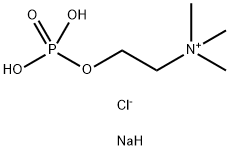phosphorylcholine
- CAS NO.:107-73-3
- Empirical Formula: C5H15ClNO4P
- Molecular Weight: 219.6
- MDL number: MFCD00871728
- EINECS: 203-516-6
- SAFETY DATA SHEET (SDS)
- Update Date: 2025-07-04 15:21:15

What is phosphorylcholine?
Description
Phosphorylcholine (abbreviated ChoP) is the hydrophilic polar head group of some phospholipids, which is composed of a negatively charged phosphate bonded to a small, positively charged choline group. It is a choline ester which forms a part of the phosphatide molecule, and as such occurs in nearly all organs. It probably often exists in the free state, being liberated from the phosphatides by enzymic hydrolysis.
Chemical properties
White crystal or crystalline powder, slightly fishy odor. Melting point 200~205°C(sealed tube). Has deliquescence. Insoluble in general organic solvents such as benzene, chloroform and ether, slightly soluble in ethanol and acetone, soluble in methanol, easily soluble in water, 10% aqueous solution pH=4.8~5.0.
Characteristics
Phosphorylcholine, unlike most of the choline esters, is very stable towards alkaline and acid hydrolytic agents; this stability is attributed to the betaine structure of the compound. It is hydrolysed by kidney, bone, and serum phosphatase.
The Uses of phosphorylcholine
Phosphocholine is an intermediate in the synthesis of Uridine Diphosphate Choline Ammonium Salt (U829930), which is CDPcholine cholinephosphotransferase analog. Pipeline device with Phosphorylcholine surface treatment (Pipeline Shield) could mitigate device material related thromboembolic complications.
Definition
ChEBI: Phosphorylcholine chloride is an organic chloride salt comprising a choline phosphate cation and chloride anion. It contains a phosphocholine and a chloride.
Preparation
Phosphorylcholine was synthesised from choline chloride and phosphorus pentoxide, the solvent being 100 percent. phosphoric acid [phosphorylation method of Manaka, 1931]. 2.4 g choline chloride, dried over phosphorus pentoxide, were dissolved in 15 g. 100 per cent. phosphoric acid, the solution was heated at 70°C. in vacuo until evolution of HC1 ceased, and 5 g. phosphorus pentoxide were added. The mixture, which became homogeneous after a few minutes, was kept at 70°C. for 3 hours. The clear viscous solution was poured into 400c.c. of ice water, and a barium hydroxide solution, saturated at 50°C., was added until the solution showed a strongly alkaline reaction. At the end of the neutralisation a smell of trimethylamine appears. The barium phosphate was centrifuged, the excess of barium ions removed by carbon dioxide, the precipitate centrifuged, and the solution reduced in vacuo to a small volume. It still contained a certain amount of barium ions depending on the amount of negatively charged phosphorylcholine ions present. The latter is determined by the pH of the solution. The amount of barium ions present was determined in an aliquot part of the solution by precipitation with sulphuric acid, and the amount of n-sulphuric acid required for complete precipitation of the barium ions added.
Enzyme inhibitor
This choline phosphomonoester (FWzwitterion = 183.14 g/mol; CAS 107-73- 3), also known as choline phosphate and phosphorylcholine, is a key intermediate in the biosynthesis of many phospholipids. Both the free acid and the calcium salt are very soluble in water. The free acid is relatively stable in acidic conditions: only 15% is hydrolyzed in five hours in 1 M HCl at 100°C. Under alkaline conditions, there is complete hydrolysis after four hours by refluxing with barium hydroxide. The phosphocholine chloride calcium salt is stable for months at room temperature. Target(s): 1-alkyl-2-acetylglycerophosphocholine esterase, or platelet-activatingfactor acetylhydrolase; choline-sulfatase; choline sulfotransferase; ethanolamine kinase; ethanolamine-phosphate cytidylyltransferase; glutamate decarboxylase; glycerophosphocholine cholinephosphodiesterase; ornithine decarboxylase; phosphoethanolamine Nmethyltransferase; phosphoserine phosphatase; and sphingomyelin phosphodiesterase, or sphingomyelinase.
Properties of phosphorylcholine
| Melting point: | 108-111 °C (decomp) |
| Boiling point: | 103 °C(Press: 12 Torr) |
| storage temp. | Inert atmosphere,Room Temperature |
| solubility | Methanol (Slightly), Water (Sparingly) |
| form | Oil |
| color | Colourless |
Safety information for phosphorylcholine
Computed Descriptors for phosphorylcholine
phosphorylcholine manufacturer
JSK Chemicals
New Products
4,4-Difluoropiperidine hydrochloride tert-butyl 9-methoxy-3-azaspiro[5.5]undecane-3-carboxylate Indole Methyl Resin N-Isopropylurea N,N-Dicyclohexylcarbodiimide(DCC) MELDRUMS ACID 5-METHYLISOXAZOLE-4-CARBOXYLIC ACID Magnessium Bis glycinate Zinc ascorbate 1-bromo-2-butyne 2-acetamidophenol 9(10H)-anthracenone Erythrosin B, 4-Piperidinopiperidine 2-((4-morpholinophenylamino) (methylthio) methylene) malononitrile 2,4-dihydroxybenzaldehyde 3-(4-morpholinophenylamino)-5-amino-1H-pyrazole-4-carbonitrile Methyl 2-methylquinoline-6-carboxylate 2,6-dichloro-4-nitropyridine 4-Bromo-2-chlorobenzonitrile 2-(benzylamino)acetic acid hydrochloride 4-(tert-Butoxycarbonylamino)but- 2-ynoic acid 3,4-dihydro-2H-benzo[b][1,4]dioxepine 1-Phenyl-1-cycloprppanecarboxylicacidRelated products of tetrahydrofuran


![PHOSPHORYLCHOLINE, [METHYL-3H]](https://img.chemicalbook.in/StructureFile/ChemBookStructure3/GIF/CB6250090.gif)





You may like
-
 Phosphoryl choline ,99% 107-73-3 99%View Details
Phosphoryl choline ,99% 107-73-3 99%View Details
107-73-3 -
 3-(4-amino-1-oxoisoindolin-2-yl)-1-methylpiperidine-2,6-dione 98%View Details
3-(4-amino-1-oxoisoindolin-2-yl)-1-methylpiperidine-2,6-dione 98%View Details -
 614-19-7 98%View Details
614-19-7 98%View Details
614-19-7 -
 3112-85-4 Methyl phenyl sulfone 98%View Details
3112-85-4 Methyl phenyl sulfone 98%View Details
3112-85-4 -
 20677-73-0 (2,2-diethoxyethyl)methylamine 98%View Details
20677-73-0 (2,2-diethoxyethyl)methylamine 98%View Details
20677-73-0 -
 3-(4-(hydroxyamino)-1-oxoisoindolin-2-yl)piperidine-2,6-dione 98%View Details
3-(4-(hydroxyamino)-1-oxoisoindolin-2-yl)piperidine-2,6-dione 98%View Details -
 57381-49-4 2-bromo-4-chlorobenzonitrile 98%View Details
57381-49-4 2-bromo-4-chlorobenzonitrile 98%View Details
57381-49-4 -
 4,6-dichloropyrimidine-5-carbaldehyde 98%View Details
4,6-dichloropyrimidine-5-carbaldehyde 98%View Details
5305-40-8
